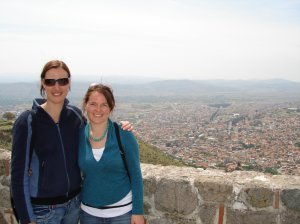Advertisement
Published: February 25th 2008

 The Old Pergamum
The Old Pergamum
Beth & Hannah - over looking BergamaAcropolis. Simple concept: Acro = top, polis = city… yep it’s a city on a hill. But its not until you get there, that you realise Akropol, as its known here, is so much more than a mere city on a hill.
This ancient city, once ruled by one of Alexander the Great’s generals, has a number of important artefacts and ruins, including the alter of Zeus (mostly sitting in a museum somewhere), the temple of Athena and the temple of Trajan which still has part of the marble columns standing.
More remarkably, a massive 10,000 seat theatre was constructed in the steep hillside, and due to the geography they had to build the theatre to an impressive height, as they couldn’t build it any wider. As you walked down the stairs, you felt that one small trip would send you tumbling all the way to the bottom, no doubt in many pieces.
Parchment paper was invented here as a way to record things. Obviously it was easier and cheaper to work with than stone, bit it also gave then a powerful trading tool. To this day there stands a tree high at the top of the city

 Akropol
Akropol
High up on the hill above Pergamumthat is from the seed of the original tree used to create the paper and it is still a tradition to tie pieces paper to this symbolic tree.
Due to this paper, the people of Akropol were able to make books, and hence they had quite a substantial library with over 200,000 volumes housed in it - quite a few considering how long ago that was! However, these were all gifted away to Egypt to win the heart of a girl… and meet their fate from a large fire. What a waste!
Next stop was on the other side of Bergama (or Pergamum as it was previously known) to the Asclepion, the hospital. It was founded by Archias, but later renowned by Galen (AD131-210) whose work was the basis of western medicine well into the 16th Century.
A Roman bazaar street, once lined with shops, leads you up to the hospital. You arrive at the ceremony area where a column carved with snakes still stands - symbolising the first usage of snake venin in medicine and is a symbol still used today!
The hospital used a number of methods for healing including: group therapy in the

 Akropol Theatre
Akropol Theatre
So steep, if you slipped, there wouldn't be much to pick up at the bottom - but what a view!large amphitheatre; radio-therapy from the ‘radio-active’ water at the well; psycho-therapy where they used to walk them through a dark, wet tunnel with small openings above and the doctors would talk to them as if they were god telling them they were healed - and also threw snakes down: shock therapy!
Brent and I couldn’t help trying the radioactive water at the sacred well, still running from the spring deep under ground. It tasted a bit strange, but we’re both still alive so it can’t have been that bad!
We walked through the dark tunnel to the Temple of Telesphorus (a god of medicine), a circular where some patients would live, sleep and walk around and around in circles hoping that Telesphorous would send a cure or diagnosis in a dream. The names of Telesphorus’ two daughters, Hygeia and Panacea have passed through into medical terminology, still used today. Talk about history in the making!
We made and unscheduled stop at the Temple of Artemis, one of the 7 ancient wonders of the world.
Ephesus, a city which we will see tomorrow, used to earn a sizable sum of money from pilgrims paying homage to the ancient

 Parchment Paper Tree
Parchment Paper Tree
Paper is still tided to this tree, which from a seed of the original used to create parchment paperAnatolian fertility goddess - Artemis (also known as Cybele).
In its prime, the temple was larger than the Parthenon at Athens, with 27 columns all with figures carved around the base. However, little more than one pillar and a few foundation stones now remain at the site.
Next we stopped at the carpet making factory, where we were give a live demonstration on how rugs were made, including how silk is extracted from the worms, different knots and the various combinations between silk, cotton and wool type carpets.
The silk-silk rugs were so soft and fine, but took months and months to complete just a small sized rug.
We were taken into their showroom to see hundreds of different styled rugs. However, the one that most of the group liked, a large aqua silk on silk rug, was ₤20,000! and the cheap rugs started around ₤600! - a little outside my price range.
Tonight was party night, and a chance for us to get to know everyone a bit better, but with only three hours sleep, quite a few of us were shuffling around pretty slowly the next day as we explore possibly thee best preserved

 Tunnel of Arches
Tunnel of Arches
Tunnels through lower AkropolRoman city anywhere, Ephesus.
Check out more
Photos
Advertisement
Tot: 0.143s; Tpl: 0.012s; cc: 14; qc: 80; dbt: 0.0745s; 1; m:domysql w:travelblog (10.17.0.13); sld: 1;
; mem: 1.2mb


















